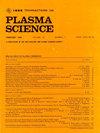Analysis of the Differences in the Optimum Triggering Positions and Projectile Velocities in Multistage Induction Coilguns for Different Arrangements of the Drive Coil Current Directions
IF 1.3
4区 物理与天体物理
Q3 PHYSICS, FLUIDS & PLASMAS
引用次数: 0
Abstract
The direction of the excitation current through the drive coils (or simply the coils) of the successive stages in a multistage induction coilgun can either be maintained the same (i.e., same direction) or reversed alternatively (i.e., alternating direction). The optimum triggering position of the armature (or the projectile) inside each stage coil changes accordingly in these two launcher configurations to achieve the highest muzzle velocity, which is also different for these two launcher configurations. This article presents a finite-element method (FEM)-based analysis on the differences in the projectile’s optimum triggering positions inside each stage coil and the achieved muzzle velocities for the same and the alternating directions of the drive coil currents in a four-stage induction coilgun. The reasons for the differences in the projectile’s optimum triggering positions inside each coil for the two launcher configurations are explained in this article in two ways: 1) by comparing the mutual inductance gradients between the projectile and each coil of the two types of launchers as the projectile travels from coil 1 to coil 4 and 2) by comparing the optimum propelling force profiles of the projectile in both types of launchers. Furthermore, this article shows that the muzzle velocity of the projectile increases by alternatively reversing the direction of the excitation current through the coils of the successive stages in a multistage induction coilgun rather than maintaining the current in the same direction. The reasons behind the enhancement in muzzle velocity are explained in this article by analyzing the armature capture effect and active duration of the accelerating force on the projectile for the two types of launcher configurations.不同驱动线圈电流方向布置对多级感应线圈炮最佳触发位置和弹丸速度的影响分析
在多级感应线圈枪中,激励电流通过连续级的驱动线圈(或简单地线圈)的方向可以保持相同(即相同方向)或交替(即交替方向)。在这两种发射装置中,为了达到最高的初速,各级线圈内的电枢(或弹丸)的最佳触发位置也会发生相应的变化,这两种发射装置的配置也是不同的。本文采用有限元方法,分析了四级感应式线圈炮在各级线圈内弹丸最佳触发位置和驱动线圈电流交变方向下实现初速的差异。在两个发射器配置的炮弹的最佳触发位置在每个线圈内的差异的原因是在这篇文章中解释了两种方式:1)通过比较的互感梯度之间的弹丸和两种类型的发射器的每个线圈作为弹丸从线圈1到线圈4和2)通过比较的最佳推进力剖面的弹丸在两种类型的发射器。此外,本文还表明,在多级感应式线圈炮中,通过交替地改变激励电流通过连续级线圈的方向,而不是保持电流在同一方向上,可以增加弹丸的初速。本文通过分析两种发射装置配置下的电枢捕获效应和弹丸加速力的有效持续时间来解释初速增强的原因。
本文章由计算机程序翻译,如有差异,请以英文原文为准。
求助全文
约1分钟内获得全文
求助全文
来源期刊

IEEE Transactions on Plasma Science
物理-物理:流体与等离子体
CiteScore
3.00
自引率
20.00%
发文量
538
审稿时长
3.8 months
期刊介绍:
The scope covers all aspects of the theory and application of plasma science. It includes the following areas: magnetohydrodynamics; thermionics and plasma diodes; basic plasma phenomena; gaseous electronics; microwave/plasma interaction; electron, ion, and plasma sources; space plasmas; intense electron and ion beams; laser-plasma interactions; plasma diagnostics; plasma chemistry and processing; solid-state plasmas; plasma heating; plasma for controlled fusion research; high energy density plasmas; industrial/commercial applications of plasma physics; plasma waves and instabilities; and high power microwave and submillimeter wave generation.
 求助内容:
求助内容: 应助结果提醒方式:
应助结果提醒方式:


